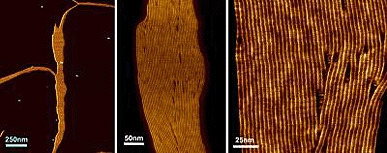The pores mimic the activity of cellular ion channels, which are vital to health as they restrict materials allowed to enter cells.
According to a statement, the pores built by the scientists are permeable to potassium ions and water, but not to other ions such as sodium and lithium ions.
This kind of selectivity, while prominent in nature, is unprecedented for a synthetic structure, said University at Buffalo chemistry professor Bing Gong, PhD, who led the study.
The project’s success is said to lay the foundation for an array of new technologies. In the future, scientists could use the pores to purify water, kill tumours, or otherwise treat disease by regulating the substances inside of cells.
‘The idea for this research originated from the biological world, from our hope to mimic biological structures, and we were thrilled by the results,’ Gong said. ‘We have created the first quantitatively confirmed synthetic water channel. Few synthetic pores are so highly selective.’
To create the synthetic pores, the researchers developed a method to force rigid macrocycles to pile on top of one another. The scientists then stitched these stacks of molecules together using hydrogen bonding. The resulting structure was a nanotube with a pore less than a nanometre in diameter.
‘This nanotube can be viewed as a stack of many, many rings,’ said Xiao Cheng Zeng, University of Nebraska-Lincoln Ameritas University professor of chemistry. ‘The rings come together through a process called self-assembly, and it’s very precise. It’s the first synthetic nanotube that has a very uniform diameter. It’s actually a sub-nanometre tube. It’s about 8.8 angstroms.’
The next step in the research is to tune the structure of the pores to allow different materials to selectively pass through, and to figure out what qualities govern the transport of materials through the pores, Gong said.
The research will appear on 17 July in Nature Communications.
The study’s lead authors are Xibin Zhou of Beijing Normal University; Guande Liu of Shanghai Jiao Tong University; Kazuhiro Yamato, postdoctoral scientist at UB; and Yi Shen of Shanghai Jiao Tong University and the Shanghai Institute of Applied Physics, Chinese Academy of Sciences.
Other institutions that contributed to the work include the University of Nebraska-Lincoln and Argonne National Laboratory. Frank Bright, a SUNY Distinguished Professor of chemistry at UB, assisted with spectroscopic studies.





Poll: Should the UK’s railways be renationalised?
I think that a network inclusive of the vehicles on it would make sense. However it remains to be seen if there is any plan for it to be for the...